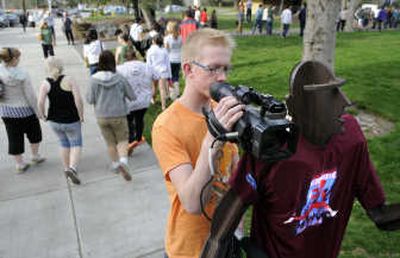Art of the run

Three buses pull up to the DoubleTree Hotel in Spokane on Friday afternoon before Bloomsday weekend. A camera crew jumps out of each and starts filming as the other passengers pour out behind them.
Every year, students from the Victoria School of Performing and Visual Arts in Edmonton come to run and film themselves running in Bloomsday. The project is a collaboration of the film’s director, Steve Ashford, who teaches video studies, and Ray Jorgensen, who teaches physical education.
This is their sixth year filming the Bloomsday trip. In 2003 there were 28 students on board. Now there are 160. Most of them will be among the 47,507 entrants and 2,600 wheelcair racers registered as of 9 p.m. Saturday.
“We did the documentary and things just exploded,” Ashford says.
Then he turns to the film’s narrator, one of his students who also is an actor, to review the film’s script as another student pans the scene at the nearby Convention Center with a digital camera. Jorgensen joins them.
“Quiet on the set,” Ashworth exclaims.
The narrator, with the camera rolling and Jorgensen at his side, begins to speak.
“As with any journey, the most common refrain you will hear is …,” the narrator begins.
Ashworth interrupts. He has the crew run through several takes.
“Be smoother,” he tells his narrator. “It looks a little sloppy.”
Then he turns to his young cameraman, “Do you have two good ones?”
“I totally got it,” the cameraman says. But Ashworth has the student shoot one last take for good measure.
All the students on the trip are actors in this film. Of course they know they are being filmed. The trick “is trying to capture the event without affecting the subject,” Ashworth says.
He accomplishes this by filming students early and often, wherever they are, whatever they are doing.
“We wear them down,” Ashford says. “We are attempting to blend art with the run itself.”
It is Ashworth’s film, but it is Jorgensen’s run.
He requires every student on the trip to train for Bloomsday. In his way, Jorgensen is as tough a task master as Ashworth. The students, grades seven through 12, and some of the parents, have been training for two months, three times a week.
There are races closer to home, but none like Spokane’s.
“It’s well organized. There are bands, people turn on their sprinklers for you,” Jorgensen says. “It’s a friendly fun race with plenty of activities.”
And the collaboration between the physical education and video studies departments has attracted more and more students each year. This year, Victoria School brought friends, a busload of students and parents from Edmonton Christian School.
“We now have some parents that want to run with their kids, fostering family fitness,” Jorgensen says.
One of those parents is Simon Spurrier, who came with his 13-year-old daughter, Stephanie, who plays French horn.
Operated by Edmonton Public Schools, Victoria School of Performing and Visual Arts is reputed to be one of the top arts schools in North America and one of the only schools in Canada to offer the International Baccalaureate program from kindergarten through 12th grade.
“The level of academic studies is very high,” Spurrier says.
Students with letters of reference may apply for entrance in any of five programs: design and new media, visual arts, theater, music and dance.
Eleventh-grader David Kelso says Bloomsday is the school’s most anticipated event. Each participant pays $290 (Canadian) for the four-day trip.
“It’s just the best experience of the year,” says Kelso, a camera operator.
The director has five students staffing the race, and all of them have press passes. A two-person video-audio team will film runners at the start and finish. Another two-person crew will be stationed at Doomsday Hill. A fifth camera operator will rove the course.
After the final edit, each participant gets a DVD memory of trip.
“Instead of just being a race, it’s an art form,” Ashworth says.